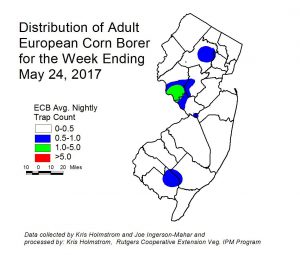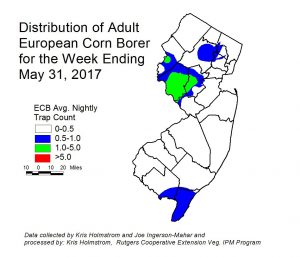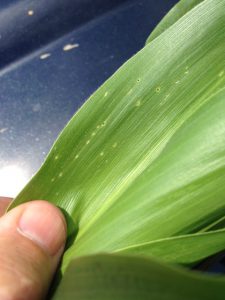There has been little change in European corn borer (ECB) catches over the past week. We would have expected some increase throughout the state, but prolonged wet weather has likely slowed their activity. The highest catches remain in southern Hunterdon County (see map at left), although there have been low, but steady catches elsewhere, including northern Cumberland and central Morris counties. Feeding continues to be very limited, but should increase with drier conditions later this week. Check 5 plants each in 10 random locations for a 50 plant sample. Look for “shot-hole” injury (see photo at right), and consider treating when the number of infested plants in a 50 plant sample exceeds 12%. [Read more…]
Potato | Tomato Disease Forecast 6-2-17
Click to View | Download Report 6-2-17
We will be tracking DSVs for Late blight development and calculating P-days for initiating the first early blight fungicide application.
The first late blight fungicide application is recommended once 18 DSVs accumulate from green row. Green row typically occurs around the first week in May in southern NJ. An early season application of a protectant fungicide such as mancozeb (Dithane, Manzate, Penncozeb) or Bravo (chlorothalonil) as soon as the field is accessible is suggested. Please be vigilant and keep a lookout for suspect late blight infections on young plants. No late blight has been reported in our region to date.
Remember the threshold for P-days is 300! Once 300 P-days is reached for your location, early blight fungicide applications should be initiated. Growers who are interested in using this model should choose the location above that is closest in proximity to their farming operation and should regularly check the Cornell NEWA website (http://newa.cornell.edu) where this information is compiled from. Click on Pests Forecasts from the menu, select your weather station, and click on tomato diseases, set accumulation start date, and a table of daily and total DSVs will be generated.
Disease severity values (DSVs) for early blight, septoria leaf spot, and tomato anthracnose development are determined daily based on leaf wetness (due to rainfall, dew) and air temperature.
On a daily basis DSV values can range from 0 to 4 where 0 = no chance for disease development to 4 = high chance for disease development. DSVs are accumulated during the production season.
Fungicide applications are based on an individually determined DSV threshold. The first fungicide application for the control of these three diseases is not warranted until 35 DSVs have accumulated from your transplanting date. After that, growers can base fungicide applications on different DSV thresholds.
Reports generated by Ryan Tirrell
Rutgers, The State University of New Jersey
Potato | Tomato Disease Forecast 5-26-17
Click to View | Download Report 5-26-17
We will be tracking DSVs for Late blight development and calculating P-days for initiating the first early blight fungicide application.
The first late blight fungicide application is recommended once 18 DSVs accumulate from green row. Green row typically occurs around the first week in May in southern NJ. An early season application of a protectant fungicide such as mancozeb (Dithane, Manzate, Penncozeb) or Bravo (chlorothalonil) as soon as the field is accessible is suggested. Please be vigilant and keep a lookout for suspect late blight infections on young plants. No late blight has been reported in our region to date.
Remember the threshold for P-days is 300! Once 300 P-days is reached for your location, early blight fungicide applications should be initiated. Growers who are interested in using this model should choose the location above that is closest in proximity to their farming operation and should regularly check the Cornell NEWA website (http://newa.cornell.edu) where this information is compiled from. Click on Pests Forecasts from the menu, select your weather station, and click on tomato diseases, set accumulation start date, and a table of daily and total DSVs will be generated.
Disease severity values (DSVs) for early blight, septoria leaf spot, and tomato anthracnose development are determined daily based on leaf wetness (due to rainfall, dew) and air temperature.
On a daily basis DSV values can range from 0 to 4 where 0 = no chance for disease development to 4 = high chance for disease development. DSVs are accumulated during the production season.
Fungicide applications are based on an individually determined DSV threshold. The first fungicide application for the control of these three diseases is not warranted until 35 DSVs have accumulated from your transplanting date. After that, growers can base fungicide applications on different DSV thresholds.
Reports generated by Ryan Tirrell
Rutgers, The State University of New Jersey
Veg IPM Update: Week Ending 5/24/17
Warmer weather has resulted in the first consistent European corn borer (ECB) catches. The highest catches have occurred in southern Hunterdon County (see map at  left), although there have been low, but steady catches elsewhere, including northern Cumberland and central Morris counties. As yet, feeding has been very limited, with only single-digit infestation rates on whorl corn found in Mercer County. With continued moderate temperatures, expect feeding in whorl stage corn to increase significantly over the next week. Check 5 plants each in 10 random locations for a 50 plant sample. Look for “shot-hole” injury (see photo at right), and consider treating when the number of infested plants in a 50 plant sample exceeds 12%.
left), although there have been low, but steady catches elsewhere, including northern Cumberland and central Morris counties. As yet, feeding has been very limited, with only single-digit infestation rates on whorl corn found in Mercer County. With continued moderate temperatures, expect feeding in whorl stage corn to increase significantly over the next week. Check 5 plants each in 10 random locations for a 50 plant sample. Look for “shot-hole” injury (see photo at right), and consider treating when the number of infested plants in a 50 plant sample exceeds 12%.
The highest nightly ECB catches for the previous week are as follows:
| Sergeantsville 4 | Denville 1 |
| South Branch 3 | East Vineland 1 |
| Allentown 1 | Eldora 1 |
A few corn earworm (CEW) continue to appear in blacklights throughout the state. These individuals indicate that there was limited overwintering of this pest in NJ, but are of little concern in the absence of silking sweet corn.
Cole Crops
IPM personnel continue to observe infestations of crucifer flea beetle. These beetles can build to high populations quickly, especially where wild mustard and related cruciferous weeds are common. Extreme feeding on small transplants can cause irreversible damage if not controlled promptly. [Read more…]
Potato | Tomato Disease Forecast 5-23-17
Click to View | Download Report 5-23-17
We will be tracking DSVs for Late blight development and calculating P-days for initiating the first early blight fungicide application.
The first late blight fungicide application is recommended once 18 DSVs accumulate from green row. Green row typically occurs around the first week in May in southern NJ. An early season application of a protectant fungicide such as mancozeb (Dithane, Manzate, Penncozeb) or Bravo (chlorothalonil) as soon as the field is accessible is suggested. Please be vigilant and keep a lookout for suspect late blight infections on young plants. No late blight has been reported in our region to date.
Remember the threshold for P-days is 300! Once 300 P-days is reached for your location, early blight fungicide applications should be initiated. Growers who are interested in using this model should choose the location above that is closest in proximity to their farming operation and should regularly check the Cornell NEWA website (http://newa.cornell.edu) where this information is compiled from. Click on Pests Forecasts from the menu, select your weather station, and click on tomato diseases, set accumulation start date, and a table of daily and total DSVs will be generated.
Disease severity values (DSVs) for early blight, septoria leaf spot, and tomato anthracnose development are determined daily based on leaf wetness (due to rainfall, dew) and air temperature.
On a daily basis DSV values can range from 0 to 4 where 0 = no chance for disease development to 4 = high chance for disease development. DSVs are accumulated during the production season.
Fungicide applications are based on an individually determined DSV threshold. The first fungicide application for the control of these three diseases is not warranted until 35 DSVs have accumulated from your transplanting date. After that, growers can base fungicide applications on different DSV thresholds.
Reports generated by Ryan Tirrell
Rutgers, The State University of New Jersey
Potato | Tomato Disease Forecast 5-19-17
Click to View | Download Report 5-19-17
We will be tracking DSVs for Late blight development and calculating P-days for initiating the first early blight fungicide application.
The first late blight fungicide application is recommended once 18 DSVs accumulate from green row. Green row typically occurs around the first week in May in southern NJ. An early season application of a protectant fungicide such as mancozeb (Dithane, Manzate, Penncozeb) or Bravo (chlorothalonil) as soon as the field is accessible is suggested. Please be vigilant and keep a lookout for suspect late blight infections on young plants. No late blight has been reported in our region to date.
Remember the threshold for P-days is 300! Once 300 P-days is reached for your location, early blight fungicide applications should be initiated. Growers who are interested in using this model should choose the location above that is closest in proximity to their farming operation and should regularly check the Cornell NEWA website (http://newa.cornell.edu) where this information is compiled from. Click on Pests Forecasts from the menu, select your weather station, and click on tomato diseases, set accumulation start date, and a table of daily and total DSVs will be generated.
Disease severity values (DSVs) for early blight, septoria leaf spot, and tomato anthracnose development are determined daily based on leaf wetness (due to rainfall, dew) and air temperature.
On a daily basis DSV values can range from 0 to 4 where 0 = no chance for disease development to 4 = high chance for disease development. DSVs are accumulated during the production season.
Fungicide applications are based on an individually determined DSV threshold. The first fungicide application for the control of these three diseases is not warranted until 35 DSVs have accumulated from your transplanting date. After that, growers can base fungicide applications on different DSV thresholds.
Reports generated by Ryan Tirrell
Rutgers, The State University of New Jersey


